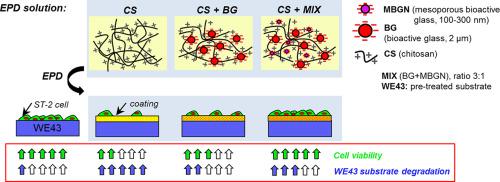Surface & Coatings Technology ( IF 5.3 ) Pub Date : 2021-04-29 , DOI: 10.1016/j.surfcoat.2021.127232 Agnieszka Witecka , Svenja Valet , Michał Basista , Aldo Roberto Boccaccini

|
Mg-based materials are good candidates for biodegradable bone regeneration implants due to their favorable mechanical properties and an excellent compatibility with human bone. However, too high corrosion/degradation rate in body fluids still limits their applicability. Coatings based on chitosan (CS) and bioactive glass (BG) particles fabricated by electrophoretic deposition (EPD) on Dulbecco's Modified Eagle Medium (DMEM) pre-treated magnesium alloys have promising potential to suppress the substrate corrosion and additionally to incorporate bioactivity. However, the impact of processing parameters or type of coating components on the long-term substrate corrosion behavior and cell response have not been investigated previously. In this study, two types of composite coatings based on a high molecular weight CS (Mw 340–360 kDa, DDA ≥ 95%) and embedded particles: solid BG (2 μm) and a mixture of BG and mesoporous bioactive glass nanoparticles (MBGN, 100–300 nm with mesopores 2.3–5.6 nm) were fabricated by EPD on DMEM pre-treated WE43 magnesium alloy. It was found that partial replacement of BG particles with MBGN (ratio 3:1) in the composite coating increases the water contact angle, surface roughness and induces a positive cell response. Although the acidic CS-based solutions and applied EPD conditions may decrease the stability of the temporary barrier formed during the DMEM pre-treatment on WE43 substrate therewith slightly increasing its corrosion sensitivity, the composite coating with a mixture of different sizes of particles (BG, MBGN) is a promising candidate for bone regeneration applications.
中文翻译:

在WE43镁合金上电泳沉积高分子量壳聚糖/生物活性玻璃复合涂层
镁基材料由于其良好的机械性能以及与人体骨骼的优异相容性,因此是可生物降解的骨再生植入物的良好候选材料。但是,体液中腐蚀/降解率过高仍然限制了其适用性。基于壳聚糖(CS)和生物活性玻璃(BG)颗粒的涂层,通过在Dulbecco的改良Eagle Eagle介质(DMEM)预处理的镁合金上进行电泳沉积(EPD)制成,有望抑制基材腐蚀并具有生物活性。但是,以前尚未研究过加工参数或涂料组分类型对长期基材腐蚀行为和电池响应的影响。在这项研究中,基于高分子量CS(M w340–360 kDa,DDA≥95%)和包埋颗粒:EPD在DMEM上制备了固体BG(2μm)以及BG和中孔生物活性玻璃纳米颗粒(MBGN,100–300 nm,中孔2.3–5.6 nm)的混合物预处理的WE43镁合金。发现在复合涂层中用MBGN(比例3:1)部分替代BG颗粒会增加水接触角,表面粗糙度并引起积极的细胞反应。尽管基于CS的酸性溶液和所施加的EPD条件可能会降低在WE43基板上进行DMEM预处理期间形成的临时阻挡层的稳定性,从而略微提高其腐蚀敏感性,但是复合涂层具有不同大小的颗粒(BG, MBGN)是骨再生应用的有希望的候选者。









































 京公网安备 11010802027423号
京公网安备 11010802027423号